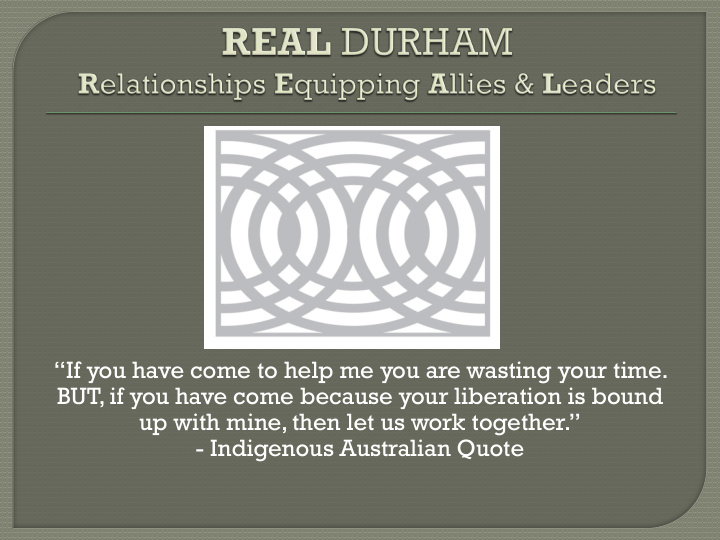



“ If you have come to help me you are wasting your time. BUT, if you have come because your liberation is bound up with mine, then let us work together.” - Indigenous Australian Quote
The Model: National Circles Initiative Goals support individuals/families as they move out of poverty and into self-sufficiency create authentic relationships and social capital eliminate barriers to economic stability in Durham
Data on the National Circles Campaign outcomes July 2008-December 2012
How the model works: training for Circle Leaders training for Allies match Circle Leaders with Allies Circle Leader peer relationships = bonding social capital Circle Leader & Ally relationships = bridging social capital
Role of the Circle Leader complete 15 week training with cohort of 15-25 participants decide to join a circle make goals and work toward goals attend Weekly Meetings with all REAL Durham participants reciprocity
Role of Allies complete training decide to join a circle make goals and work toward goals support Circle Leader in achieving goals 4 – 10 hours per month commitment • 1 – 2 community meetings monthly • enjoy spending time with Circle Leader
Chart data from July 2008 – Dec 2012
“To be impoverished is to be an internal alien, to grow up in a culture that is radically different from the one that dominates the society. The poor can be described statistically; they can be analyzed as a group. But they need a novelist as well as a sociologist if we are to see them. They need an American Dickens to record the smell and texture and quality of their lives.” (Harrington,1962)
“The association between health and poverty is among the most robust findings of social epidemiology” ( Geronimus, 2000) “..the complex web of causation— including poverty; racism; and the political, social, and economic environment — places enormous challenges before public health professionals committed to the elimination of disparities” (Quinn & Thomas, 2008)
First Generation Document the existence of health & health care disparities Second Generation Explain Reasons for Disparities Third Generation Provide Solutions for reducing or eliminating disparities
Third-generation health disparity research rests on three key pillars: trans-disciplinary research, community engagement, and translation of evidence-based best practices. The trans-disciplinary approach is a “process by which collaborators work jointly on a problem from the very onset, using a shared conceptual framework that draws together discipline specific, theories, models, methods, and measures into a new synthesis” ( Rosenfield, 1992)
Solutions to eliminate racial and ethnic health disparities among urban populations living in poverty must address institutional racism and other structural forces fueling racial/ethnic inequality in income, neighborhood conditions, educational achievement, and political enfranchisement.
“Efforts to develop the next generation of prevention interventions must focus on building relationships with communities, and develop interventions that derive from the communities’ assessments of their needs and priorities. Models should be developed that encourage members of the community and researchers to work together to design, train for, and conduct such programs” (Institute of Medicine, 2000)
Circles represents the culmination of evidence based best practice, multiple disciplines, the dignity, expertise and strengths of community residents, and the collective passion of diverse people converging to eradicate and eliminate poverty and the systemic barriers that keep people in poverty.
Where? • We will focus primarily on families and households within the EDCI Zone during the first two years.
Who? • We will target households and families struggling with material poverty that are generally identified as the working poor. When? • We will begin our first Circles Leaders training in February 2014 & Circle Allies training Mid April 2014.
FAQ’s How is this model different from other Circles? What does a weekly meeting look like? What’s the time commitment? How will you know it’s working? How do we receive updates and information?
How can you help? • Become a Circle Leader • Become a Circle Ally • Join a Team on the Guiding Coalition • Volunteer for childcare, meals, transportation, teach a class, etc. • Host a Cost of Poverty Experience (COPE) event to raise awareness. • Support financially
THANK YOU for your support! Please make checks payable to: DCIA subject line: REAL Durham
Recommend
More recommend